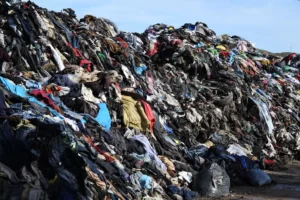Sustainable fashion is a term that’s increasingly used these days, as we all become ever more aware of the serious environmental impact of our clothes. We first have to understand what exactly sustainability means in the fashion industry. Sustainability refers to creating and consuming clothes in a “sustained” way that protects the environment and those producing the clothes. Additionally, true sustainability should ensure that the creation process is environmentally and socially sound, from materials to manufacturing all the way to workers’ conditions and fair pay. Needless to say, this is a big change for an industry that for years has struggled with wasteful operations and negative environmental consequences.
By taking a closer look, we can see that there are several areas of focus to these conversations. These areas include awareness, materials and processes.

The fashion industry is responsible for 8-10% of humanity’s carbon emissions more than all international flights and maritime shipping combined (UNEP, 2018). If the fashion sector continues on its current trajectory, that share of the carbon budget could jump to 26% by 2050 (Ellen MacArthur Foundation, 2017). What’s more, 85% of all textiles go to the dump each year (UNECE, 2018), and washing some types of clothes sends significant amount of microplastics into the ocean. There are 500,000 tons of microfibers are released into the ocean each year from washing clothes the equivalent of 50 billion plastic bottles (Ellen MacArthur Foundation, 2017). Some 93 billion cubic metres of water enough to meet the needs of five million people is used by the fashion industry annually, contributing significantly to water scarcity in some regions (UNCTAD, 2020)
Understanding the impact of materials is crucial when it comes to making more sustainable purchases. A good rule of thumb is to avoid virgin synthetics such as polyester which makes up 55 per cent of clothes globally as these are derived from fossil fuels and take years to break down. Not all natural materials are made the same: organic cotton, for example, uses significantly less water than conventional cotton and doesn’t use harmful pesticides. Look for certifications from the Global Organic Textile Standard (for cotton and wool), Leather Working Group (for leather) and Forest Stewardship Council (for viscose) to ensure the materials used to make your clothes have a lower impact on our planet.
The implementation of sustainable fashion starting from ourselves, both fashion brands and consumers. One way that consumers can make an impact in the fashion industry is by changing their own consumption habits around constantly buying and discarding clothing.

fast fashion, the opposite of sustainable fashion is relatively new in human history. Before mass-produced clothing, the textile crafts of handmade artisan products required specialized skills, such as fabric dyeing and handloom weaving, that reflected the fine arts and identity of makers and their cultures. The traditional arts of handmade and hand-dyed clothing reflect the beauty and storytelling power of “slow fashion.” By taking care of garments repairing them when they need support, reusing them rather than buying the latest trends consumers can get more use out of their clothes, reducing the demand for fast fashion. Additionally, taking care of clothes can offer opportunities to reflect on the cultural heritage of the products they own and the identity of the clothing makers and their communities.













